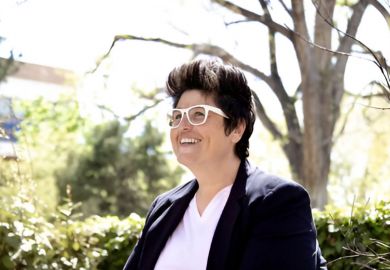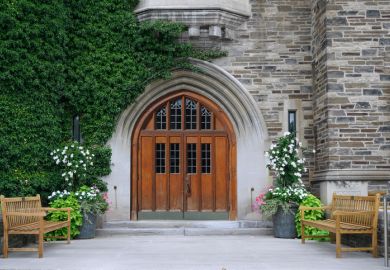Many higher education institutions have reacted to the killing of George Floyd earlier this year by pledging to do more to redress racial inequities at all levels of their organisation, from the classroom to the president’s office. Yet how can we be sure that this change moves beyond superficial fixes to true, sustainable cultural shifts?
In his recent bestselling book, How to Be an Antiracist, Ibram Kendi, founding director of Boston University’s Center for Antiracist Research, posits that it is not enough to simply not be racist. We must be actively anti-racist. And this is not solely the work of the diversity office.
Currently, Black, Indigenous and other people of colour (BIPOC) bear a disproportionate burden in service responsibilities and student support. Departmental chairs should establish a shared spreadsheet to track faculty departmental service. Duties should be regularly reviewed and reapportioned. Provide compensation for those who are overtasked or actively lighten their other responsibilities.
In addition, chairs should create anonymous feedback channels for colleagues with marginalised identities and allow these faculty to participate in ways that make sense to them in representing their perspectives.
It is also important to ask whether faculty from marginalised identities are celebrated in the same way as faculty from the dominant perspective are. If not, elevate marginalised voices. Give credit through amplification and attribution. Be keenly aware of who is represented on all media outlets. The aim is representation, not tokenism.
Administrators can also support faculty to address systemic oppression by requiring them to explicitly state, in their reflections on teaching for promotion and tenure, how they have incorporated inclusive pedagogical practices. And student evaluations of teaching can include questions about equity and inclusion.
For faculty, the first step on this journey is to commit time and effort to learning about yourself, your domains of privilege, your internalised racism and the impact of these on your pedagogical practices. Ask yourself: “What can I give up in order for others to benefit?” Dismantling systems of oppression will cost us all something.
Reframe your syllabi. We won’t be able to actually “decolonise” them because true decolonisation refers to repatriation. At a minimum, however, ensure that required texts are inclusive of authors from diverse perspectives; if there are none available, explicitly address with your students why this is so. Talk honestly about how your particular discipline has been engaged in or furthered systemic oppression, even if only historically.
Ideally, we want to move beyond diversifying courses towards creating space and elevating marginalised perspectives, ensuring that we credit ideas, methods and frames that have been devalued and misappropriated. Highlight diverse scholars and professionals via guest lectures. If you don’t know any colleagues who don’t look like you, ask yourself why.
We must also review our programme curricula. Are some courses used as gatekeeping mechanisms? Does your degree really require calculus when it’s not applicable to academic or professional work in that area? Are there important perspectives missing? Does your dance degree require ballet but only offer West African dance as an elective?
Reflect also on your teaching practice. Establish agreements with the students on principles of classroom etiquette, such as listening before speaking, demonstrating mutual respect, using “I” language (rather than making comments and assumptions about others) and asking questions to propel conversation, not stop it. Define key terms, model how to engage and avoid tokenism (such as asking a student to speak on behalf of an entire group of people). Be ready to directly and constructively react to student comments that perpetuate inequalities.
Evaluate your understanding of professionalism and its proximity to whiteness. Do you promote or give advice – solicited or not – about appearance and communication styles? If you realise that you have been perpetuating culturally oppressive standards because your professional organisation does so, change your approach. Provide a mechanism for students to understand how they’ll be judged and how to work around or within that system while also acknowledging that it needs to change.
Similar considerations apply to academic advising. The key is to inform on what is needed to succeed, without judgement. Avoid snap, implicitly biased judgements of what level of difficulty students can handle, and what professions they can aspire to (and be aware of their own biased perspectives of self-limitation). Never define for a student their capabilities, only focus on what options they have and what they need to accomplish to take advantage of those options.
As for letters of recommendation, be aware that they contain revealed biases towards members of underrepresented communities and can be riddled with micro-aggressions. Educate yourself on mistakes to avoid. Focus on skill and accomplishments.
Nor is research free of bias and bad practice. If you are researching underrepresented populations, collaborate with a research partner from that perspective. If you are performing research in a foreign country and working with people from underrepresented populations, give appropriate recognition for authorship on papers. This applies to your undergraduate researchers, too.
If you are asked to give a talk or be on a panel, ask who else is represented and, if necessary, challenge underrepresentation (by supplying names of suitable colleagues).
Becoming an anti-racist academic is an ongoing process. But we hope that such pointers can mobilise faculty and move the conversation towards continuous personal reflection and a commitment to create a campus environment that is inclusive and safe for all.
Chisomo Selemani is an associate professor in the communication sciences and disorders programme at Baldwin Wallace University, Ohio. Anna Young is an associate professor and director of the zoo and conservation science programme at Otterbein University, Ohio.
Register to continue
Why register?
- Registration is free and only takes a moment
- Once registered, you can read 3 articles a month
- Sign up for our newsletter
Subscribe
Or subscribe for unlimited access to:
- Unlimited access to news, views, insights & reviews
- Digital editions
- Digital access to THE’s university and college rankings analysis
Already registered or a current subscriber?








